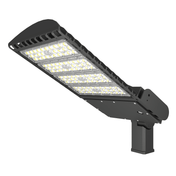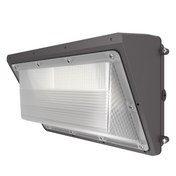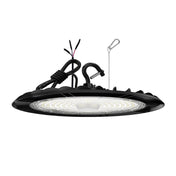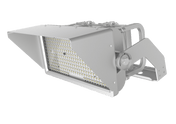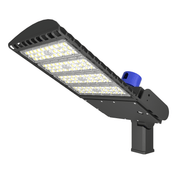What Are LED High Bay Lights, Exactly?
LED high bay lights are specialized lighting fixtures designed for spaces with high ceilings—typically 15 feet (4.5 meters) or higher. Unlike standard ceiling lights, they’re engineered to deliver powerful, uniform illumination across large areas while withstanding the unique demands of industrial, commercial, and warehouse environments. At their core, these fixtures use light-emitting diodes (LEDs) as the light source, replacing outdated options like metal halide, high-pressure sodium (HPS), or fluorescent tubes. What sets them apart? Their compact design, energy efficiency, and ability to direct light precisely where it’s needed make them ideal for spaces like manufacturing plants, distribution centers, gymnasiums, and big-box retail stores.
Common Types of LED High Bay Lights
Not all LED high bays are the same—choosing the right type depends on your space and needs. Here are the most popular varieties:
-
Linear LED High Bays: Long, narrow fixtures perfect for spaces with narrow aisles (e.g., warehouses or retail stockrooms). They distribute light evenly along their length, reducing shadows between rows of shelving. Many come with mounting options like surface mount or suspension chains.
-
UFO LED High Bays: Named for their round, disc-like shape, these are the most common type. They’re versatile, easy to install, and provide 360-degree light distribution—ideal for open spaces like manufacturing floors or gymnasiums. Their compact design also makes them great for areas with limited ceiling clearance.
-
Low Bay vs. High Bay: While high bays suit ceilings 15ft+, low bay LED lights are for 10-15ft ceilings (e.g., auto repair shops or small warehouses). Don’t confuse the two—using a high bay in a low-ceiling space can cause glare, while a low bay in a high-ceiling area will lack brightness.
Key Specs to Understand Before Buying
Navigating LED high bay specs can be overwhelming, but these four metrics are non-negotiable:
-
Lumens (Not Watts): Watts measure energy use; lumens measure brightness. For high-ceiling spaces, aim for 10,000-20,000 lumens per fixture (e.g., a 100W LED high bay = ~13,000 lumens). Calculate total lumens needed by multiplying your space’s square footage by 50-100 lumens/sq ft (higher for task-heavy areas).
-
Color Temperature (CCT): Measured in Kelvin (K), it determines light warmth. For industrial spaces, 5000K-6500K (cool white) is best—it boosts alertness and visibility. For commercial areas like retail, 3000K-4000K (warm white) creates a more inviting atmosphere.
-
Color Rendering Index (CRI): Rates how accurately light shows colors (0-100). Choose 80+ CRI for spaces where color matters (e.g., quality control, auto painting) to avoid misjudging hues.
-
IP Rating: Ingress Protection measures dust/water resistance. IP65 is standard for industrial spaces (dust-tight, water-resistant to jets), while IP67 is for wet areas (e.g., food processing plants).
Installation Tips for Maximum Performance
Poor installation can ruin even the best LED high bays. Follow these guidelines:
-
Mounting Height & Spacing: Hang fixtures 1.5-2x the ceiling height apart. For example, 20ft ceilings = 30-40ft between fixtures. This ensures uniform coverage without dark spots.
-
Wiring Safety: Turn off power before installation. Use a licensed electrician if wiring is complex—LEDs run on DC power, so fixtures need a compatible driver (most come pre-installed, but verify voltage matching).
-
Directional Adjustment: Some high bays have adjustable brackets. Tilt them slightly toward work zones (e.g., assembly lines) for targeted light, but avoid glare by angling away from eye level.
Maintenance & Longevity Hacks
LED high bays last 50,000-100,000 hours, but proper care extends their life even further:
-
Regular Cleaning: Dust buildup on lenses reduces brightness by 20-30%. Wipe fixtures with a dry microfiber cloth every 3-6 months (use a damp cloth for greasy areas like auto shops).
-
Check Drivers: The driver is the fixture’s “brain”—if it fails, the light won’t work. Inspect for loose wires or overheating (discoloration) annually. Choose fixtures with replaceable drivers for easy repairs.
-
Avoid Overheating: LEDs hate heat. Ensure fixtures have proper ventilation (avoid enclosed spaces) and don’t stack items near them—heat shortens lifespan by 10-15% for every 10°C increase.
Why Upgrade to LED High Bays?
If you’re still using traditional lighting, the upgrade benefits are undeniable: 75% lower energy bills (vs. metal halide), 5x longer lifespan, instant on/off (no warm-up time), and dimmable/smart control options. For example, a warehouse with 100 metal halide fixtures (400W each) spends ~$9,000/year on lighting. Switching to 100W LED high bays cuts that to ~$2,250/year—saving $6,750 annually.
Conclusion: Invest in the Right LED High Bay
LED high bay lights aren’t just a lighting upgrade—they’re a long-term investment in efficiency, safety, and cost savings. By understanding types, specs, installation, and maintenance, you can choose fixtures that fit your space perfectly. Whether you’re lighting a warehouse, factory, or gym, the right LED high bays will deliver bright, reliable light for decades while slashing your operational costs. Ready to make the switch? Start by calculating your lumens needs and prioritizing quality fixtures from trusted brands—your space (and wallet) will thank you.




